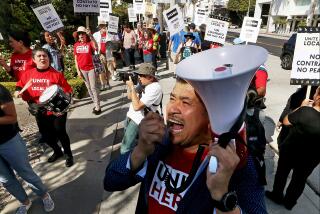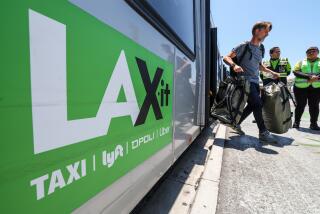Legal Costs Mounting for LAX Proposal
Legal costs are mounting to defend the city against a lawsuit challenging its controversial modernization plan for Los Angeles International Airport, even as Mayor-elect Antonio Villaraigosa has said he supports only part of the proposal.
In the last 18 months, bills for outside counsel working on Mayor James K. Hahn’s LAX plan reached $4.2 million. On Tuesday morning, just three days before Hahn leaves office, the Airport Commission will consider authorizing an additional $750,000.
That amount will be enough only to get the city out of the hole -- it owes two law firms for expenses tallied in April, May and June as well as part of July. Airport officials will have to ask for more money next month.
“The very reason we’re only asking for money to get us through July is we don’t know exactly what the new administration would want us to do -- so their choices are protected,” said Claudia Culling, a senior assistant city attorney.
The additional money would bring the total for the contract to about $5 million for services provided by environmental attorneys at Akin Gump Strauss Hauer & Feld and the law firm of James A. Geocaris. The city has spent about $11 million for all legal costs connected with the LAX plan since 1996.
Joe Ramallo, a spokesman for Villaraigosa, said the mayor-elect, one of three Los Angeles City Council members to vote against the $11-billion proposal, has often spoken of his misgivings about the legal costs.
The “numbers are consistent with the mayor-elect’s concern about the master plan, that we would end up spending more on legal expenses than we would on actually expanding our regional capacity,” he said.
Ramallo declined to comment specifically on the most recent request because he said he hadn’t seen the agenda or board reports for Tuesday’s meeting.
In the past, Villaraigosa has been outspoken about the city’s increasing reliance on expensive outside law firms. He requested a review last year of such spending after The Times reported that outside legal billings had doubled in the five years ending with the 2002-03 fiscal year.
The growing legal costs at LAX come amid uncertainly about what Villaraigosa, who becomes mayor on Friday, will do with Hahn’s airport plan.
Villaraigosa has said he approves moving forward with the most popular projects, including a transit hub near the Century Freeway and Aviation Boulevard, a consolidated rental car center in parking lot C and the relocation of the southernmost runway 55 feet closer to El Segundo.
But Villaraigosa wants to abandon the more controversial elements, including a check-in center near the San Diego Freeway. It’s unclear whether he can do this without having to redo the proposal’s complex and costly environmental studies.
After the City Council approved Hahn’s plan in December, several airport-area cities and residents filed lawsuits against Los Angeles claiming that the studies had failed to adequately analyze the effects of the project on noise, air pollution and traffic.
The cases were consolidated and the next hearing is set for August, although the city’s attorneys plan to ask for an extension until October. Culling, the only lawyer from the city attorney’s office assigned full time to work on Hahn’s modernization plan, estimates that the city’s airport agency will need up to $250,000 a month to pay the two firms to prepare for the hearing.
Partners at Akin Gump, an international firm with offices in Los Angeles, charge $395 an hour, while Geocaris bills $250 an hour, but will start receiving $275 as of Friday.
The two firms have performed a variety of services for the city, including work on the plan to mitigate air pollution, noise and traffic effects associated with the proposal. They also will compile briefs and other documents for the lawsuit, negotiate settlements with plaintiffs and draw up a $500-million benefits agreement with airport-area residents.
Culling said their services are necessary because they have the technical expertise required to review the environmental studies, which, after nearly 10 years and $150 million, now stack 19 1/2 feet high. After the lawsuits were filed, she said, the attorneys had to compile an administrative record of the proposal that filled 100 boxes.
“This is huge, just huge,” Culling said. “There’s an extensive amount of work that goes into just about everything we’re doing.”
More to Read
Sign up for Essential California
The most important California stories and recommendations in your inbox every morning.
You may occasionally receive promotional content from the Los Angeles Times.










